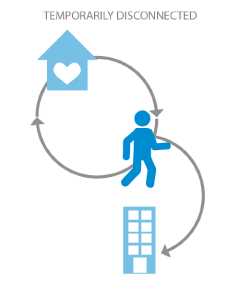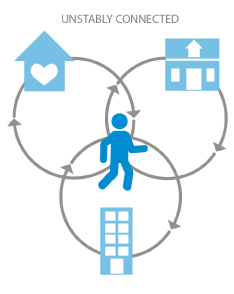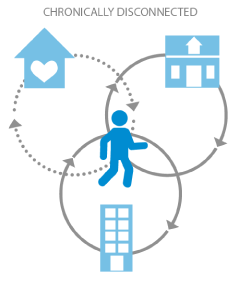Many different terms are used to describe young people who are homeless, including street youth, street kids, runaways, homeless youth, etc. Youth homelessness refers to young people who are living independently of parents and/or caregivers, and importantly, lack many of the social supports deemed necessary for the transition from childhood to adulthood. In such circumstances, they do not have a stable or consistent residence or source of income, nor do they necessarily have adequate access to the support networks needed to foster a safe and nurturing transition into the responsibilities of adulthood. Few young people choose to be homeless, and the experience is generally negative, unpleasant, stressful and distressing.
There is no formally agreed upon age definition of a homeless youth (or in many cases, even a youth) in Canada. However, there is a Canadian Definition of Homelessness that has received wide support from community groups, government and researchers. A youth definition of homelessness is in the process of being created. While it will follow the Canadian Definition in terms of types of homelessness, it will distinguish the unique pathways that youth follow into homelessness.
Even within the proposed definition there is recognition that it is being created to help provide some definitional coherence despite not necessarily reflecting specific program, policy and jurisdictional definitions that already exist.
Depending on the jurisdiction, the state will define the ages for which child protection services are responsible for care, what kinds of mental health supports are accessible and the age when one can live independently, obtain welfare and other government benefits, or leave school, etc. (Coming of Age: Reimagining the Response to Youth Homelessness in Canada).
The category of youth therefore can range from 12 to 29. According to the census youth means those aged 12-19, while young adults includes individuals between 20 and 29. A young person under the Youth Criminal Justice Act is someone over the age of 12 and younger than 18. Federally, the age of majority is considered to be 18 (when youth are allowed to vote) but in many provinces youth cannot buy alcohol until 19 years of age.
The child welfare mandate is determined by the provinces and territories and the age of protection ranges from under 16 to under 19. This means, for example, that youth leaving home or being removed from their home under these ages fall under the responsibility of the child welfare system. However, above these ages children can be “aged out[1]” of foster care and restrictions may be placed on new entries. This is particularly true in Ontario where new access to the child welfare system is extremely limited for 16 and 17 year olds. A bill before the Ontario Legislature to address this issue died on the order papers before it could be approved into law.
Most youth homeless services in Canada provide supports beginning at 16 or 18 and continuing up to the youth’s 25th birthday. Age is an important consideration because the developmental needs of youth vary from those of adults, but also vary within the youth category itself. The “needs, circumstances, and physical and emotional development of a 14 year old compared to an 18 year old or a 23 year old [are different] (though it must also be acknowledged that the factors that produce and sustain youth homelessness – including violence, trauma and abuse, may also contribute to developmental impairment for older youth)” (Coming of Age: Reimagining the Response to Youth Homelessness in Canada).
Over the course of the year the number of young people who become homeless in Canada is at least 40,000 and there may be as many as 7,000 homeless youth on any given night.
The Government of Canada estimates 1 in 5 shelter users in this country are youth between the ages of 16 and 24. Males outnumber females by a ratio of 2:1 in most shelters (very little specific data is collected about trans*[2] youth). Segaert reports that 63% of youth in shelters are male, and 37% are female. Because of violence encountered by young women on the streets they may be more likely than young males to access alternatives to shelters.
While only 20% of shelter users across the country are youth, Choices for Youth reports that youth make up 30% of the homeless population in St. John’s, Newfoundland.
There is significant overrepresentation amongst homeless youth who identify as lesbian, gay, bisexual, trans*, queer or 2-spirited (LGBTQ2S). They are estimated to make up 25-40% of the youth homeless population, compared to only 5-10% of the general population.
Additionally, as with the homeless adult population, there is significant overrepresentation of Aboriginal youth. Furthermore, depending upon location there may be an increase in the number of homeless youth of colour (i.e. black youth in Toronto).
Pathways into and out of homelessness vary. We know that over 40% of homeless youth have been involved with the child welfare system and over half of homeless youth have previous involvement with the criminal justice system. Additionally, homeless youth experience greater mental health issues (40-70% compared to only 10-20% for housed youth).
The key causes of youth homelessness include a) individual / relational factors, b) structural factors and c) institutional and systems failures:
- Individual and Relational factors - A main cause of youth homelessness is a breakdown or conflict in key relationships within the home. The vast majority have chosen or been forced to leave an unsafe, abusive, neglectful or otherwise untenable situation. Many young people leave home because of mental health problems or addictions issues that either they or someone else in their household is experiencing.
- Structural factors - This includes ongoing problems that a young person cannot control, and which largely originate outside of the family and exist at a broader societal level. This includes social and economic conditions like poverty, inadequate education, underemployment and lack of housing stability, which may also frame the experience of young people and can underlie stressors within the family that can lead to conflict; meaning “home” is no longer a viable option. Discrimination in the form of homophobia, transphobia, racism and bullying can also be contributing factors.
- Institutional system failures - Sometimes young people become homeless after slipping through the cracks of our “social safety nets” (such as child protection, health and mental health care, juvenile justice). Many young people in government care (child protection) become homeless when their placement breaks down leaving them without a place to live, or choose to leave their placements; and/or have been discharged from a situation of care (e.g., for non-compliance) without a place of residence to which they can or will return. That we discharge young people from systems of care without adequate discharge planning and ongoing supports increases the risk of homelessness.
Homeless youth may be physically on the streets, staying in emergency shelters or youth hostels, “couch-surfing” with friends or family, renting cheap rooms in boarding houses or hotels, or staying in squats. All of these are risky housing situations, which may lead to imminent loss of shelter. Homeless youth, also tend to move between various housing situations over time as outlined in the typology below, which has been expanded from the National Alliance to End Homelessness. Gaetz argues that “it is the instability of their housing situation that characterizes their status as homeless youth”.
Youth homelessness is defined by inherent instability, profound limitations and poverty. At a time when these young people are experiencing loss and potentially trauma, they are simultaneously charged with managing a diverse and complex set of tasks, including obtaining shelter, income and food, making good decisions and developing healthy relationships (Coming of Age: Reimagining the Response to Youth Homelessness in Canada).
Youth homelessness then must be considered separately from adult homelessness. Just as the pathways into homelessness are different, so are the possible interventions and solutions. Homeless youth generally are leaving a situation – whether it is family, child welfare or correctional services – where they were dependent upon adult caregivers for their overall support.
Becoming homeless then does not just mean a loss of stable housing, but rather leaving a home in which they are embedded in relations of dependence, thus experiencing an interruption and potential rupture in social relations with parents and caregivers, family members, friends, neighbours and community (Coming of Age: Reimagining the Response to Youth Homelessness in Canada).
The diversity of homeless youth notwithstanding, the lack of experience with independent living is an important factor. This toolkit presents models of supported transitional housing that can help homeless youth make the adjustment and develop the skills necessary to live and thrive on their own.
The NAEH Typology of Youth Homelessness

Temporarily Disconnected
As Kuhn and Culhane point out, the vast majority of people who become homeless do so for a very short time, typically find their way out of homelessness with little assistance and rarely return to homelessness. This is as true for adults as it is for youth. The NAEH suggests that between 81 and 86 percent of homeless youth fit into this category. This group is characterized as generally being younger, as having more stable or redeemable relations with family members, a less extensive history of homelessness and are more likely to remain in school. There is a strong need for prevention and early intervention to divert this population from the homelessness system.
 Media Folder:
Media Folder:

Unstably Connected
This population of homeless youth has a more complicated housing history and is likely to have longer and repeated episodes of homelessness. They are more likely to be disengaged from school and will have challenges in obtaining and maintaining employment. Most will have retained some level of connection with family members and are less likely to experience serious mental health or addictions issues than chronically homeless youth. This is a group for which family reconnection interventions, as well as transitional housing programs are recommended, particularly for youth under 18.

Chronically Disconnected
Adapted from the Coming of Age report.
[1] Refers to the process of a child becoming independent and leaving the child welfare system. Many homeless youth have become too old to remain under the jurisdiction of the child welfare system and yet lack the necessary skills to live independently.
[2] Trans* is an umbrella term that signifies the broad diversity of gender variance found within the transgender community including, but not limited to, transgender, transsexual, agender, bigender, genderqueer, genderfluid, non-binary etc.

